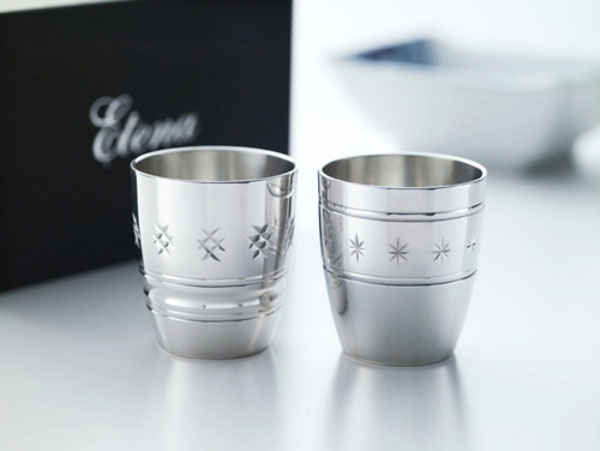
- Metal works
- Tokyo
Tokyo antimony craft Tokyo antimony kogeihin
Byproduct of the Meiji Restoration
Graceful crafts leading the export industry of Japan
Description
What is Tokyo antimony craft ?
Tokyo Antimony Craft is metalwork produced in the area from the northeast of Tokyo through to Abiko City in Chiba prefecture. Antimony is an alloy, which easily takes impressions, has a smooth surface and does not shrink during cooling after casting; Tokyo Antimony Craft makes full use of these properties to produce fine and highly detailed features on varied articles such as accessories, figurines, presentation trophies, music boxes, and interior goods. When coated with gold, silver, or copper, pieces look incredibly luxurious. In recent years, a new tin-base alloy called "Etena" jointly developed by the Tokyo Metropolitan Industrial Technology Research Institute and Tokyo Antimony Association, has been used as it allows a mirror finish, very much like silverware; this was a great technical breakthrough as conventional tinware does not polish as well. This new development led to the production of the current Tokyo Antimony Craftwork with its beautiful shine.
History
The origin of antimony products dates back to 1877, just after the Meiji Restoration in 1867, when casters and engravers employed as weapon makers by the Tokugawa Shogunate lost their jobs. They quickly used their initiative and established techniques to make antimony products. The antimony industry, even though being born in turbulent times, was not greatly affected by subsequent events such as the Great Kanto Earthquake, the great financial panic, global depression, and World War II. In fact, only one month after the end of World War II in 1945, a meeting to herald the resumption of the association was held. After the Antimony Industrial Cooperative Association was officially launched in 1949, the industry contributed to the national export policy to acquire foreign currencies, and developed into an industry leading Japanese economic growth. Antimony products contributed strongly to the development of the export industry of Japan through the Meiji (1868-1912), Taisho (1912-1926), and Showa (1926-1989) periods. Today not only are they highly valued as Japanese traditional crafts by Europeans and Americans, but are also pervasive in their everyday life.
General Production Process
- 1. Making the model The original models of antimony products are made by highly skilled and talented craftsmen who are well acquainted with each stage of production. Depending on the design, craftsmen choose either wooden or plaster models.
- 2. Making the casting mold Using the original model, sand molds are formed, into which brass alloy is poured to make a metal mold for each part. These parts are combined to make a casting mold; the mold is carefully assembled and hammered to increase its strength. For finishing, the casting mold is lathed and filed and polished with charcoal. Next, any details, designs, or images are engraved into the casting mold, by using a graver and nanako chisel (a chisel where the tips of the chisel form a circle). Before World War II, traditional Japanese patterns such as flowers and birds, natural scenes, and Mt. Fuji were popular, whereas today, there has been a gradual shift to modern and Western style designs. Engraving is the most difficult task and requires the most expertise of all the stages of production. The engraving techniques have not changed since the Meiji period, and since the metal mold is made of a brass alloy, it is possible to engrave exquisitely fine details.
- 3. Casting There are four casting methods: yakibuki, modoshibuki, hiyashibuki, and jiganebuki. In yakibuki, the casting mold is heated in a furnace at about 300 to 350ºC, which is the melting temperature of antimony, and then removed. Molten metal is then poured into the mold, which is then gradually cooled with water. The temperature of the molten alloy in the casting mold, the angle of the casting mold, the flow speed of the alloy, and air removal are all dependent on the craftsman’s years of skill and experience. In modoshibuki, the molten alloy is poured from the gate of the casting mold, and after 10 to 15 seconds, the molten alloy is removed from the mold; this technique can be applied to any shape, and mainly used for such products as figurines or jewelry boxes. Hiyashibuki is a simple method in which the water cooling used in yakibuki is omitted. Jiganebuki is a method in which the casting mold is heated by floating on molten metal. These two methods are used in the casting of small-sized products.
- 4. Finishing After removing the piece from the casting mold, it is carefully finished with special tools until the seams are no longer distinguishable.
- 5. Plating When plating with copper, gold, or silver, a copper coat is always applied first. After plating, transparent enamel may be applied to prevent rust.
- 6. Coating For plated pieces, a transparent coating is applied to prevent discoloration of the surface.
See more Metal works
- Nambu ironware
- Takaoka copperware
- Yamagata cast iron
- Sakai cutlery
- Tokyo silverware
- Echizen cutlery
- Osaka naniwa pewterware
- Tosa cutlery
- Tsubame-tsuiki copperware
- Shinshu Forged Blades
- Banshu-miki cutlery
- Higo inlays
- Echigo-sanjo cutlery
- Echigo-yoita cutlery
- Chiba Artisan Tools
- Tokyo antimony craft
See items made in Tokyo
- Edo kiriko cut glass
- Edo wood joinery
- Edo glass
- Murayama-oshima tsumugi silk
- Tokyo silverware
- Edo patterned paper
- Tokyo fine-patterned dyeing
- Edo bamboo fishing rods
- Tama brocade
- Hachio island silk
- Woodblock prints
- Tokyo textiles
- Edo-sekku doll
- Edo Hyogu (Art Mountings)
- Edo Oshi-e Pictures on Embossed Fabric
- Edo tortoise shell crafts
- Tokyo Honzome Chusen
- Tokyo Koto (Japanese Harp)
- Tokyo Plain Dyeing
- Tokyo Shamisen
- Tokyo antimony craft































































































































































































































































































